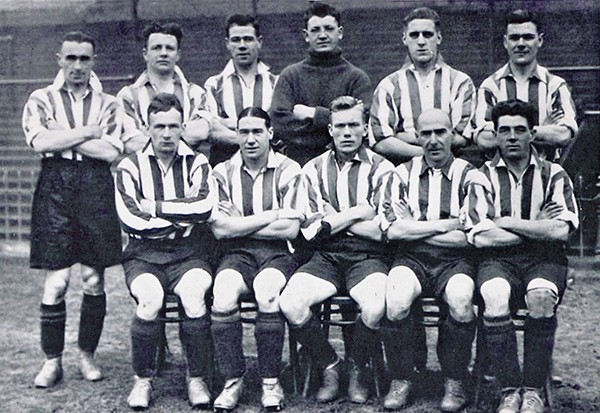
Pictured above: Jimmy Dunne, front row, centre, in his Sheffield Utd days.
Jimmy Dunne was one of the finest soccer players that Ireland has ever produced. No Irishman has ever matched his record of goalscoring at the highest level. For club and country he found the back of the net consistently and in great number, year after year.
His talent took him across the sea to England, to test himself against the best. In the steel country of Yorkshire, under the bright lights of London town and down by the south coast, he met the challenges and passed the tests. He survived and thrived, he scored and scored.
James Dunne was born in Dublin on September 3rd, 1905, and lived on Cambridge Road in Ringsend. As a youngster, Jimmy was a talented footballer who clearly had the potential to make it professionally. But during the Civil War his soccer journey was temporarily halted when he was interned in the Curragh for a year. Soon after his release in 1923 his impressive performances in junior soccer with Parkview FC got him noticed and signed by Shamrock Rovers.
For some reason he had a bad time with the Hoops, and couldn’t even get into the team. Fortunately, a scout from England saw something in him. In 1925 Jimmy joined New Brighton FC, a fourth division team. The move worked out, and he scored six goals in his first eight games.
Such fine displays ensured that Jimmy didn’t spend long in the lower league and in February 1926 his career took a huge leap forward when he was signed by Sheffield United, a First Division club.
But his trials were not over, and his early seasons in Yorkshire were disappointing. He just could not break into the team. He was transfer listed, and it seemed like he was surely on his way out. Then, suddenly, after three fruitless years, everything came together for Jimmy.
No one can say exactly how it happened, no one knows what changed, but something did. It all happened in the 1929/30 First Division season, which Jimmy Dunne began as a struggling scorer, unsure of his place in the team. By the time it was over, he had emerged as a super striker, a centre forward of true greatness. He had transformed himself into a football immortal, a star. During that astonishing season, he scored 36 goals in 39 games. That’s almost a goal a game!
And thanks to his goals, Sheffield United were saved from relegation that year. With Jimmy starring, they remained in the First Division for the next five years.
His record of that era is almost beyond belief, thirty goals each season from 1930 to 1933. In 1931 he completed his greatest season of all, when he scored a phenomenal 41 league goals. No player since has equalled that tally for a top flight season in England. Jimmy Dunne was at the pinnacle of his career.
His deeds inevitably attracted the attention of other, bigger and richer, clubs. And for years, Sheffield United managed to keep their star striker. But when the club found itself in deep financial trouble, they were forced to sell him. In 1933 Arsenal FC signed Jimmy, and he went south to London.
He had, for him, an unproductive first season with Arsenal, and scored only 9 goals in 23 games. And though the club won the league title in his first year there, his time in London was a letdown. In his second year with Arsenal he lost his place in the team, and he played only eight more games in three seasons, before he left the club in 1936.
That year, he moved down to the south coast for his final season in English football, playing for Southampton FC. In his one season there, he finished as his club’s leading scorer. He scored 14 goals in 36 games of that 1936/37 season, helping save the club from relegation to the Third Division.
The Southampton fans loved Jimmy, and nicknamed him ‘Snowy’ on account of his blonde hair. Despite his popularity at the club, in 1937 he signed for Shamrock Rovers and took the job of player/manager. He was coming to the end of his time as a footballer, but it was a successful late period for Jimmy. He helped Rovers win three major trophies in three years, between 1938 and 1940.
As well as his achievements at club level, Jimmy had a mighty international record.
He had first represented his country in 1928 but, amazingly, he didn’t score in his first game! He waited more than two years before he got another game for Ireland. However the occasion of his second cap would turn out to be very much worth the wait.
It came against England, in October 1930, right when he was at his peak.
Not only did the match come at the perfect time for Jimmy, it was to be played at the perfect place for him too. While it was an away game for Ireland, it was ‘home sweet home’ for Jimmy, played at Sheffield United’s ground, Bramall Lane.
It was an era when Ireland usually lost against England, and usually lost badly. And this time… Ireland lost badly again! They were beaten by five goals to one. The one bright point, the one shining moment, that one goal came, of course, from the magic boot of Jimmy Dunne.
At the end of the match Jimmy had one goal in two games for Ireland. By the end of his international career he had clocked up 17 goals in 22 games. In club football he finished with 240 goals in 346 games.
All in all, at the heel of the hunt, put those totals together and what more needs to be said?
Jimmy Dunne.
Footballer and Ringsend Man.
He scored 257 goals in only 368 games.
By Gavan Bergin

